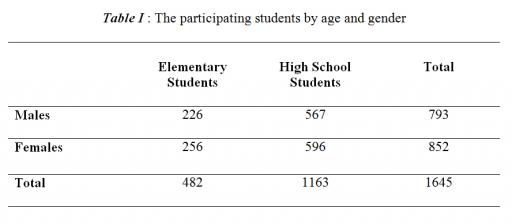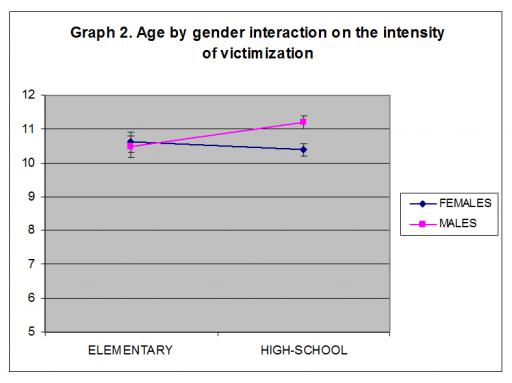PDF file here.
Click on the title to see the text.
INTRODUCTION
Bullying has been recognized as a worldwide problem (Olweus, 1993; Tanaka, 2001; Andreou, Vlachou, & Didaskalou, 2005) and research to date suggests that any school can anticipate the occurrence of bullying, albeit, with varying degrees of severity (Smith & Brain, 2000; Veenstra et al., 2005). According to various researchers (Olweus, 1993; Smith & Sharp, 1994; Roland, 1989; Hazler, 1996; Rigby, 1996; Ttofi et al., 2008), bullying is a form of aggressive behaviour, which occurs between children, mainly in school. It is deliberate and it causes physical or psychological damage and it can be expressed individually or within a group. Usually it is persistent, since it is repeated and it can last for weeks, months or even years. Bullying behaviour derives from a need to abuse power over others and a desire to dominate them. There is an inequality (imbalance) of power between bullies and victims.
A number of studies (Suckling & Temple, 2002; Olweus, 1993) have consistently shown that there are various types of bullying: physical (i.e. fighting, kicking, punching, hitting), verbal (i.e. teasing, swearing, threatening, using put-downs, spreading nasty rumours ), social (i.e. deliberately leaving out of a game or group, ignoring and not inviting to classmates’ parties), sexual bullying (i.e. making sexual comments or gestures ), and cyber (sending annoying and disturbing electronic messages over the phone or computer).
Three groups of individuals are directly involved in bullying: Bullies are the perpetrators of bullying behaviour. Olweus (1991, 1991b), argues that the main characteristics of bullies are impulsivity, aggressiveness, physical power and dominant behaviour. They appear to have a positive perception for violence, and adopt exclusively aggressive strategies in negotiating their interpersonal conflicts because they lack alternative skills for conflict resolution (Hoover et al., 1992; Wolke et al., 2004). Victims are the targets of bullying behaviour. Victims tend to show increased symptoms of anxiety and depression (Hodges & Perry, 1999), they usually have low self-esteem and poor social skills (Egan & Perry, 1998), they have difficulties remaining in school (Reid, 1983), they do not actively participate in school activities (Kochenderfer & Ladd, 1997), and they exhibit psychosomatic symptoms, as well as low self-confidence (Boulton & Smith 1994). Bully/Victims are children who are involved in bullying both as bullies and as victims. They have the highest level of adjustment problems among all children involved in bullying, showing both internalizing and externalizing problems (Nansel et al., 2001; Juvonen et al., 2003; Veenstra et al., 2005; Arseneault et al., 2006; Georgiou & Stavrinides, 2008). This group has been linked with hyperactivity symptoms and it has been found to be the most vulnerable in terms of psychopathological problems (Kumpulaine et al., 1998).
Research on the long term effects of bullying has shown that victims are at high-risk for depression and low self-confidence as adults (Olweus, 1993). Also, they are likely to have difficulties in their adult sexual life (Gilmartin, 1987). As adults, bullies have an increased chance to become involved and to be convicted for punishable actions (Whitney & Smith, 1993). Bullies also have an increased risk of later criminality and alcohol abuse; about 40 % of the former male school bullies have three or more criminal convictions by the age of 24, compared to 10 % of controls (Olweus, 1991). Some victims, bullies, and bully/victims may present suicidal ideation as well. Prewitt (1998) has shown that bullying is correlated with suicide attempts and some of those attempts have been successful. Finally, bullying may be one of the reasons for referring children to psychiatric centers (Dawkins, 1995).
EPIDEMIOLOGICAL STUDIES
Various epidemiological studies (Boulton & Underwood, 1992; Lagerspetz et al., 1982), have found that bullying is more frequent among boys than among girls, and that boys are more likely to become bullies compared to girls (Boulton & Smith, 1994). Other studies have shown that boys are more often involved in physical bullying, while girls in psychological and social/relational bullying (Stephenson & Smith, 1989). In addition, Whitney and Smith (1993) argue that physical bullying is more frequent among younger than older children. A United Nations supported survey in developed and transitional countries in Central and Eastern Europe (2001/02 Health Behaviour in School-aged Children HBSC) found that 35% of schoolchildren (ages 11-15) said they had been bullied within the past two months, with the percentage ranging from 15% in Sweden to 64% in Lithuania”. In countries such as Greece the percentage of children that said that they had been bullied within the last two months was 23% in females and 26 % in males, in USA 33% in females and 36 % in males, in the UK 32% in females and 32% in males and in France 36% in females and 34% in males. In Finland, from a sample of 8th and 9th graders (ages 14-16 years), 11% reported bullying others at least once weekly and 11% reported being bullied at least once weekly (Kaltiala-Heino et al., 1999), in Scotland from a sample of adolescents in secondary schools, 7.5% reported bullying others and 16.7% reported being victimized since the beginning of the school year (Karatzias et. al., 2002 ) and finally in Turkey, 100% of the students reported being bullied at least once during the academic year (Kepenekci & Cinkir, 2006).
The above studies however, do not report either on involvement rates or on the intensity of involvement for each particular group (i.e. bullies, victims and bully/victims). One of the earliest report to do that was in Norway in 1983 (Olweus, 1993) with a sample of 568,000 primary and secondary students. In that study, Olweus reports that 9% were classified as victims, about 7% as bullies, and about 1.6% were bully/victims.
Various other studies involving adolescents in different countries report the following findings: In the USA 13% were found to be bullies, 10.6% victims and 6% bully/victims (Nansel et al., 2001) and in the UK, in a study involving elementary school children, it was found that 4.3% were identified as bullies, 10.2% as bully/victims and 39.8% as victims (Wolke et al., 2000).
In Cyprus, from a sample of 12-15 year old Greek Cypriots from two junior high schools, 8.4% reported being bullies only, 15.25% being bully/victims and 21.5% being victims only (Kokkinos & Panayiotou, 2004). This study however had used only a small and non-representative sample and therefore any generalizations on the Cyprus student population should be made with caution.
AGE AND GENDER DIFFERENCES
Even though it is not very clear at what age (or school grade) bullying and victimization occur most frequently, there are research findings indicating that these behaviours decline with age up to the end of secondary school (Arseneault, Bowes & Shakoor, 2009; Eslea & Rees, 2001). Eslea and Rees (2001), conducted a retrospective study in which male and female adults aged 18–55 years completed questionnaires about their memories of being bullied at school. Results showed that bullying was most frequently remembered from around 11–13 years of age, with incidents from earlier and later childhood being reported comparatively rarely. Furthermore, with a sample of 15,686 students in grades 6 through 10, Nansel et al., (2001) found that the frequency of bullying was higher among 6th- through 8th-grade students than among 9th- and 10th-grade students. Taken the above findings into consideration, it then appears that bullying and victimization peak around the last grades of elementary school up to the end of junior high school.
THE PRESENT STUDY
The present study aims to investigate the epidemiological prevalence of bullying in Cyprus primary and secondary schools. Specifically, we aim at revealing an accurate percentage of the students that are involved consistently either as bullies, victims, or bully-victims. Furthermore, we seek to examine whether there are any gender or age differences in relation to the intensity of involvement in either bullying or victimization experiences.
METHOD
PARTICIPANTS
The participants of the present study were 1645 students randomly selected from schools in urban, suburban, and rural areas of Cyprus. The participants in this epidemiological study were children and adolescents from the 6th grade of primary school and from the1st, 2nd and 3rd grades of junior high school. The choice of the age-range was based on our will to include the age range during which school bullying seems to occur most frequently. The sample represents 4.2% of the elementary and junior high school student population.
The sample consists of 482 elementary students and 1163 high school students. Of those, 852 (51.8%) were females and 793 (49.2%) were males (table 1). The sample was stratified according to socioeconomic characteristics of the families of the students in order to reflect the general socioeconomic status of Cypriot families.

INSTRUMENT
We used a translated version of the Revised Bullying and Victimization Questionnaire (BVQ; Olweus, 1996). The instrument has been used in a number of recent studies in Cyprus that repeated show adequate psychometric properties (Georgiou & Stavrinides, 2008; Georgiou, 2008a; Georgiou, 2008b). For the purpose of the present study we used only the eight items of the bullying subscale and the respective eight items of the victimization subscale.
PROCEDURES
The participants completed the BVQ during 20 minutes of one school hour. The researchers explained to the children the purpose of the study and asked them to complete the instrument if they agreed to participate. The study had received a formal approval both from the Ministry of Education and Culture and the Cyprus Bioethics Committee. The children were also informed about the anonymity of the study and they were explicitly guided not to write their name or anything that would reveal their identity. Moreover, the researchers informed the participants about data protection and explained that they had the right to withdraw from the study while completing the instrument, despite their previous consent.
RESULTS
Exploratory Factor analysis (EFA) with Varimax Rotation was performed on the Revised Bullying and Victimization Questionnaire in order to examine the factor structure and the construct validity of the questionnaire in the Greek-Cypriot sample. The results revealed statistically adequate indices since the solution extracted two factors, one reflecting Bullying and the other reflecting Victimization. The total variance explained from these two factors is 51.95% and the internal consistency coefficient (cronbach alpha) for the whole scale is .87. Interestingly, the two subscales of bullying and victimization show a moderate and statistically significant positive correlation (r = .40, p < .01). Detailed psychometric properties of the BVQ are shown in table 2. The subscale of Bullying shows a mean of 10.06 and a standard deviation 4.70, and the Victimization subscale shows a mean of 10.74 and a standard deviation of 4.62.

In order to identify the epidemiological prevalence of bullying and victimization we computed on both subscales the scores of the children who show on both subscales one standard deviation above the mean (moderate bullies and moderate victims) and two standard deviations above the mean (severe bullies and severe victims). The results of this analysis reveal that 90.6% of the participants are categorized as non-involved, whereas 3.9% of the children are identified as moderately bullies and 5.5% are identified as severely bullies. In total, moderate and severe bullies account for 9.4% of the participants. On the victimization subscale, the results show that 88.7% of the children are categorized as non-involved, 4.7% are identified as moderately victims and 6.6% are identified as severely victims. In total, moderate and severe victimization accounts for up to 11.3% of the participants.
Finally, we aimed at identifying the prevalence rates of children that are uniquely bullies, uniquely victims, and bully-victims. In order to achieve that, we calculated (1) the cases of the children that are moderately and severely bullies but non-involved in victimization, (2) the cases of the children that are moderately and severely victims but non-involved in bullying, and (3) the cases of the children that are moderately and severely bullies and victims. The results of these calculations show that 83% of the children remain non-involved, 5.4% of the children are uniquely bullies, 7.4% of the children are uniquely victims, and 4.2% are bully-victims. In total, 17% of the Greek-Cypriot children are involved in bullying and victimization.
GENDER AND AGE DIFFERENCES
Multivariate analysis of variance (MANOVA) shows that boys score significantly higher on the Bullying subscale (F (1,1438) = 51.74, p < .01= .035) but there are no significant differences on the victimization subscale (F (1,1438) = .89, p = .34). Similar results are revealed when comparing age differences. High school children score significantly higher on the Bullying subscale (F (1,1438) = 4.91, p < .05) while there are no significant differences between elementary and high school students on the Victimization subscale (F (1,1438) = .69, p = .40). Interestingly, there is a significant interaction between gender and age on both bullying and victimization subscale. While girls show no age differences, high school boys are significantly more involved in bullying (F (1,1438) = 4.34, p < .05) (see graph 1). On the victimization subscale, elementary schoolgirls are more victimized than elementary schoolboys, whereas high-school boys become more victimized than high school girls (F (1,1438) = 4.15, p < .05) (see graph 2).


DISCUSSION
Our findings show that 17% of the students are involved in some form or another in bullying. These results are inline with studies following similar protocols and procedures such as Olweus (1993). Further, the distribution into the three major categories is not far from what Olweus suggests.
It is apparent from the literature that there is very little consensus internationally on the prevalence rates of bullying and this might be explained by the plethora of definitions, the samples used in each study and the instruments that are administered. Even so, the statistical computations found in various studies are also different, something that creates an enormous gap in the results between studies that apply different methods in estimating the prevalence rates of bullying. For example, while in the Turkish study (Kepenekci & Cinkir, 2006) it was found a 100% of involvement in some form of victimization, in the Finnish study the respective percentage was 11% (Kaltiala-Heino et al., 1999). In fact, our epidemiological statistics are far too closer to the more conservative findings of Finland and Norway rather than the results of Turkey.
Our study shows that 4.2% of the children in elementary and junior high school are classified as bully/victims. That means that approximately one in every twenty-five students acts as a perpetrator in some instances and as victim in others. This is an important category of students that should draw the attention of educators, psychologists, and other mental health specialists since a number of studies have shown that the bully/victim category is the highest at-risk group for negative outcomes (Haynie et al., 2001; Schwartz, 2000; Schwartz, Proctor, & Chien, 2001). In fact, another study conducted in Cyprus (Georgiou & Stavrinides, 2008) showed that bully/victims were experiencing the worst outcomes in all parameters of the study such as peer acceptance, temperament, relational and physical victimization, and deviation from the norm.
Another interesting finding of the present study is the interaction of age and gender on the intensity of bullying. It appears that age operates as moderator in the relationship between gender and bullying; as boys go through the early adolescent years (junior high school) the intensity of bullying increases, while in girls the intensity remains the same. This finding is in line with the general developmental literature on aggressive behavior which shows that during adolescence boys are more likely to become more aggressive for a number of biological (e.g. Donovan, 1985) and psychosocial reasons (e.g. Benton, 1992). A similar finding however, was found in terms of victimization as well. Adolescent boys are victimized more than adolescent girls whereas in childhood the intensity of victimization is rather equal. It is likely that this finding also reflects the overall tendency of boys to be more involved in incidents of bullying.
Finally, it is also evident when comparing the present study with other relevant studies that a need for more common methodologies and comparable statistics are needed. It is expected that cross-cultural variation in the prevalence and qualitative characteristics of bullying will always be present on one hand, but on the other hand the scientific community and the practitioners will benefit more if the data from different countries can be comparable in order to produce a wider perspective and a deeper understanding of bullying.
LIMITATIONS OF THE PRESENT STUDY
The initial aim of the present study was to investigate the prevalence rates of bullying and victimization as general phenomena, but also to identify the rates of the various subtypes of bullying and victimization as well. Our goal was to reveal the actual percentages of the students involved in physical, verbal/psychological, and social forms of bullying and victimization. The factor structure of the instrument however did not allow for such an analysis since it yielded bullying and victimization as single constructs. Therefore, any assumption and further investigation on the types of bullying and victimization would not be supported by the present data. In future studies, it is suggested to use instruments such as the BVQ with more items on the subscales of bullying and victimization. It is estimated that the limited number of items on both subscales may have contributed to the extraction of single factors.
CONTRIBUTION OF THE PRESENT STUDY
This study, in line with earlier studies, shows that a significant percentage of Cypriot students are involved in bullying either as bullies, victims, or bully/victims. This percentage of 17% indicates that bullying is not an isolated phenomenon in Cyprus schools and, therefore, our study may serve in the process of awareness of policy makers, educators, and specialists in order to promote practices of prevention and intervention. Our study, is also the first epidemiological on bullying in Cyprus, and this effort comes to fill an important lack of data in an issue that disturbs normal school functioning and precludes an important number of students in Cyprus from a healthy developmental and educational environment.
|






